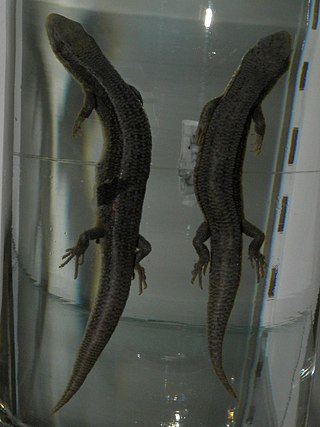
Ablepharus is a genus of skinks that contains the common snake-eyed skinks. Both their scientific and common names refer to the fact that their eyelids have fused to a translucent capsule; as in snakes, they thus are physically incapable of blinking. They are small lizards and prefer to live in the leaf litter of dry fields and hills. Their scales give them a very shiny, bronze appearance with a characteristically dark stripe down the sides of their bodies. They prey on small insects and other small mollusks.
The minor snake-eyed skink is a species of skink that can be found in India, Iran, Pakistan, Afghanistan, the mountain regions of the eastern former Soviet central Asia, and possibly Kyrgyzstan.
Ablepharus tragbulensis is a species of skink endemic to South Asia.

Riopa guentheri, commonly known as Günther's supple skink or Günther's writhing skink, is a species of skink, which is endemic to India.
Ablepharus ladacensis, also known as the Ladak ground skink, is a species of skink found in Tibet (China), North India, western Nepal, and northern Pakistan.

Ablepharus kitaibelii, commonly known as the European copper skink, European snake-eyed skink, juniper skink, or snake-eyed skink, is a species of skink, a lizard in the family Scincidae. The species is endemic to Eastern Europe and Southwestern Asia.
Ablepharus sikimmensis is a species of skink found in Bangladesh (Rangpur), Bhutan, China (Tibet), India and Nepal.

Ablepharus budaki, commonly known as Budak's skink and Budak's snake-eyed skink, is a species of lizard in the family Scincidae. The species is endemic to the Near East.

Morethia boulengeri is a species of lizard in the family Scincidae. The species is endemic to Australia and Indonesia.

Chernov's skink is a species of skink, a lizard in the family Scincidae. The species is endemic to northern Eurasia.
Ablepharus darvazi is a species of skink, a lizard in the family Scincidae. The species is endemic to Asia.

The desert lidless skink is a species of skink native to southern Kazakhstan, Kyrgyzstan, northern Tajikistan, Uzbekistan and eastern Turkmenistan.
Ablepharus lindbergi, Lindberg's snake-eyed skink or Lindberg's twin-striped skink, is a species of lizard in the family Scincidae. It is endemic to Afghanistan.
Morethia butleri, also known commonly as Butler's Morethia and the woodland Morethia skink, is a species of lizard in the family Scincidae. The species is endemic to Australia.
Panaspis seydeli, also known as the Seydel's snake-eyed skink, is a species of lidless skink, a lizard in the family Scincidae. The species is known from the Democratic Republic of the Congo and Zambia.
The Ethiopian snake-eyed skink, also known commonly as Boulenger's dwarf skink, is a species of lidless skink, a lizard in the family Scincidae. The species is endemic to Ethiopia.
Proablepharus tenuis, also known commonly as Broom's small skink and the northern soil-crevice skink, is a species of skink, a lizard in the family Scincidae. The species is endemic to Australia.

Ablepharus alaicus is a species of skink found in China, Kyrgyzstan, Uzbekistan, Tajikistan, and Kazakhstan.

The Himalaya ground skink is a species of skink found in Pakistan, India, Nepal, and Turkmenistan.
The Mahabharat ground skink is a species of skink found in Nepal.









